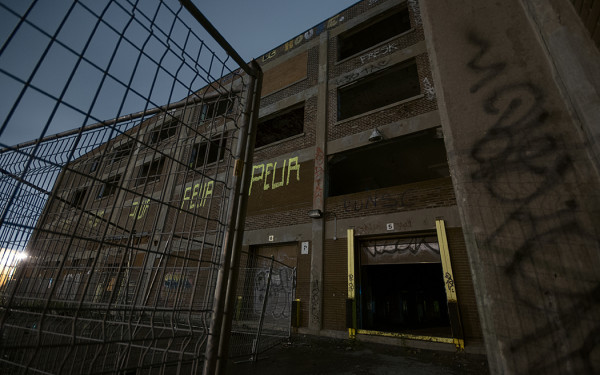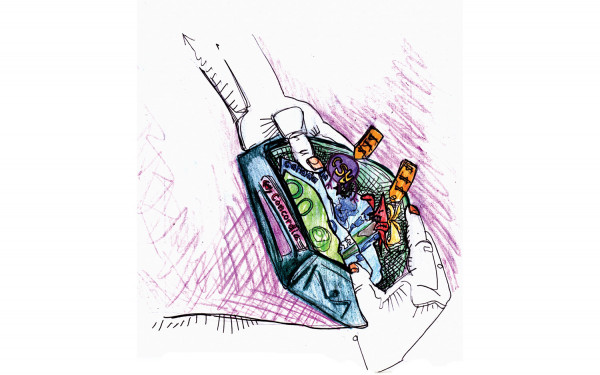Sacred Fire Productions Brings Indigenous Art Into The Mainstream
Igniting the Embers of Indigenous Art
As Canada moves to right the wrongs of its colonial past, Nadine St-Louis believes that must include the art world as well.
That’s why she founded Sacred Fire Productions in 2012. St-Louis realized that she wanted to do something she believed in, while not working under anyone else.
Sacred Fire Productions is a not-for-profit arts organization that aims to support indigenous artists in their professional recognition, accelerate social inclusion, break down stereotypes, and draw attention to the diverse cultures that exist under the descriptor of “indigenous.”
“Sacred fire means manifestation of spirit,” St-Louis said.
St-Louis also serves as the organization’s executive director. She graduated from Concordia University in 1994 with a double major in English literature and film studies. She is of Mi’kmaq, Acadian, and Scottish descent.
Sacred Fire Productions was the result of St-Louis’ desire to bring mainstream recognition and appreciation to often-ignored indigenous artists. Rather than just “stamping in and out,” St-Louis wanted to work towards something she be believed in.
And in five years, she has been very busy.
To fulfill its social mandate, Sacred Fire Productions undertakes actions meant to further the exposure of indigenous artists and contribute to their professional, economic, and personal development.
One example of this is the ASHUKAN Cultural Space. Another its annual Mixed Arts Festival.
Sacred Fire Productions also creates cultural events meant to bring indigenous and non-indigenous people together to begin a dialogue about reconciliation.
“We want to bridge cultural understanding between nations that has been eliminated from our past,” explained St-Louis.
1_900_600_90.jpg)
It is an uncommon and innovative organization that aims to promote indigenous artists, who according to St- Louis, are deeply under represented in the mainstream art ecosystem.
St-Louis explained that the Canadian federal government’s policy of assimilation made it illegal to produce artwork, to speak their language, or engage in any other kind of cultural practice such as a pow-wow.
Sacred objects, like the peace pipe or totems, were removed by the federal government and redistributed to museums. Being able to express themselves through art is an important part of First Nations culture, and being prevented from doing so was an attempt to erase them from history.
Indigenous voices are invisible in media, film, and the cultural dialogue of today’s world, said St-Louis. Sacred Fire Productions hopes to change that, in part, by creating events and a space for indigenous people.
Carmen Hathaway is one of the artists represented by Sacred Fire Productions. Born in Germany, she’s lived in Manitoba since 1974. Hathaway is a member of the Abenaki First Nation, from Odanak in Quebec.
Hathaway is a dynamic multimedia artist who creates physical paintings and glass pieces, as well as digital artwork. Her art is sold in the form of digital prints at the ASHUKAN Cultural Space.
“Traditional skills I’ve developed over 30 years as a multimedia [and] intermedia artist transfer seamlessly into digital art,” said Hathaway.
St-Louis and Hathaway first met in early 2011. “Nadine St-Louis invited me to participate in the upcoming MAMU (Together) painting symposium being held in August at Uashat, Quebec’s Shaputuan Museum,” she explained.
That led to her first exhibit with Sacred Fire Productions, which was presented for a year at Marché Bonsecours in Old Montreal.
Hathaway has been represented by the ASHUKAN Cultural Space since its inception in May 2015.
“In 2015, I accepted an invitation from ASHUKAN to present a solo exhibit in the gallery,” she said. Her multimedia presentation, From Smoke to Cyber Signals, was a part of the Montreal’s First Peoples’ Festival.
“The exhibition addresses various themes such as communication mode, symbolic and semiological representations that link contemporary indigenous experience with the legacy of the past,” according to the Sacred Fire Productions website.
Hathaway has used both video and digital technology in her evolving body of work. “Engaging in this dynamic long-distance relationship with ASHUKAN is empowering,” she said.
Though she’s a time zone and the province of Ontario away, “communication is key. Networking with Quebec-based organizations result in myriad opportunities,” explained Hathaway.
“Sacred Fire Productions is the manifestation of the spirit, not just of me. [It is] making room for the manifestation of the Nations to come through the art. [It is] making room for reconciliation, room for dialogue, economic growth, and reducing poverty.” —Nadine St-Louis
Sacred Fire Productions works with over 91 artists and creators of First Nation, Métis, and Inuit descent. According to the Sacred Fire Productions website, the average earning for an indigenous artist is $15,900 per year.
For all of last year, St-Louis served as a policy advisor to Quebec’s minister of culture. The province was in the midst of renewing its cultural policy, which was created in 1992, shortly after the 1991 Oka Crisis, and hadn’t been touched since.
“We got one paragraph in the cultural policy. Having that indigenous voice for the renewal of the cultural policy was essential to bring back the balance,” said St-Louis.
St-Louis explained that many indigenous and Inuit people create art in the northern parts of Canada, but that there isn’t space in the southern urban centres for them to be seen or heard.
An example of the barriers artists face trying to promote their work is the high transportation costs they face traveling from north to south. St-Louis has done extensive work mapping the northern parts of Quebec, often inaccessible by roads.
Finding success as an artist can be difficult, as the path to success is less predetermined than other professions. It requires you to put yourself and your work out there.
This requires time, money, and connections. Like any community, Montreal’s art world has its own social codes. Sacred Fire Productions can help artists through workshops and professional development training who are unfamiliar with its do’s and don’ts.
The Mixed Arts Festival is one of the manifestations of Sacred Fire Productions’ social mandate. This year was its fifth. It was also part of the official program for Montreal’s 375th anniversary celebrations, the theme being “reconciliation through the arts,” and was presented in mid-June.
The Mixed Arts Festival is a multidisciplinary festival that included workshops, a photo exhibit, a temporary art gallery, musical performances and more. The festival included a mixture of indigenous and non-indigenous artists.
According to St-Louis, indigenous people receive very little representation in film, and oftentimes when they are featured in film it is stereotypical and cliched, such as the sexualized and one dimensional Pocahontas archetype, explained St-Louis.
“We want to build indigenous pride through arts and culture, especially for artists who live far away,” said St-Louis.
The ASHUKAN Cultural Space is a social entrepreneurship project, birthed officially in 2015. It’s intended to be a place to create dialogue, a fair trade economy, and professional developments.
“The ASHUKAN Cultural Space is an incubator for the creation, production, and dissemination of indigenous cultures and teachings,” St-Louis said. “It is also a gathering space to bridge between nations so we can understand better their historical truths of Canada, and the impact of colonialism on indigenous artists.”
It’s the backbone of accelerating social change and of Sacred Fire Productions, said St-Louis, likening its necessity to that of a landing strip for an airplane.
The ASHUKAN Cultural Space is located in the centre of Old Montreal, in Place Jacques-Cartier. It’s spacious, bright, and filled with colourful art work. Inside, it smells faintly and pleasantly of pine.
St-Louis had many of the building’s original rooms removed to create an open space, with a pine staircase winding up to the third floor. Like many buildings in Old Montreal, its walls are composed of cobbled grey stone.
The grey stone walls are interspersed with painted white ones and bright spotlights highlighting the art.
The second floor of the space is where fair trade, indigenous-made moccasins, soap, jewelry, furs, reproductions, beading works, greeting cards, and Inuit sculptures are sold.
There is also an online store allowing the artworks to reach an international market.
It serves as both a forum to display indigenous artwork and as a fair trade boutique. Stepping into the space is an educational experience for tourists as well as Canadians, according to St-Louis.
“We have a responsibility to know whose land we’re walking on. It’s unceded territory. We have a responsibility to know the nations with whom we share the land,” said St-Louis.
St-Louis said that there are souvenir shops in Old Montreal that are flooded with cheap trinkets that are made in China, which look vaguely indigenous. She added that these objects represent cultural appropriation, as the souvenirs and their eventual profits have no involvement with the people whose cultures they claim to be representing.
One reason that this phenomena exists, according to St-Louis, was that indigenous people were viewed as invisible, which allowed the proliferation of faux indigenous souvenirs into the Canadian market.
“We’re offering 100 per cent authentic handmade indigenous items,” she continued.
“If you want true reconciliation, we need to do economic reconciliation, [in] the cultural sector,” said St-Louis. “The federal government has a responsibility to help in the reconciliation of cultural economy.
If a tourist walks into the ASHUKAN Cultural Space and asks the question, “Who made this?” they can find out exactly who the artist is and what community they’re from.
Profits go back to the artist so that they can continue to create. The souvenirs claiming to be indigenous cannot claim the same thing, and are attempting to profit off of a culture and people they have not asked, consulted, or compensated.
It is an example of cultural appropriation and fraud that St-Louis believes should be made illegal. “We’re fighting against that,” she said.
If it seems confusing that an arts organization could be so political, or be doing so many different things, St-Louis would have you understand that “the indigenous worldview is circular, that everything is interconnected. That’s why we chose the medicine wheel as our business model.” The ASHUKAN Cultural Space, its educational value, and the events are all interconnected and equally important.
Seeing that there wasn’t a space explicitly for indigenous artists to be seen and valued, St-Louis created Sacred Fire Productions and extended her vision to the ASHUKAN Cultural Space.
“I’m using what I believe in to bring me forward in life,” she said.
“Sacred Fire Productions is the manifestation of the spirit, not just of me,” St-Louis said. “[It is] making room for the manifestation of the Nations to come through the art. [It is] making room for reconciliation, room for dialogue, economic growth, and reducing poverty.”

2_900_600_90.jpg)
_600_832_s.png)




